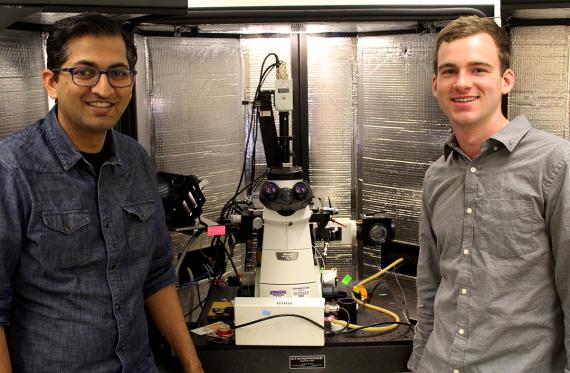Recent work by Professor David Ginger and colleagues was published online on June 19 in Nature Materials. The research was also highlighted in a News & Views article.
The Ginger group, in collaboration with Professor Christine Luscombe (Materials Science & Engineering) and the Clean Energy Institute, has discovered the basic design principles for constructing polymers that can transport both electrons and ions. This is a critical step toward making polymer-based devices at the interface of biology and electronics, such as improved biosensors and bioelectronics implants.
“Most of our technology relies on electronic currents, but biology transduces signals with ions, which are charged atoms or molecules,” said David Ginger, Alvin L. and Verla R. Kwiram Endowed Professor of Chemistry and chief scientist at the UW’s Clean Energy Institute. “If you want to interface electronics and biology, you need a material that effectively communicates across those two realms.”
UW researchers directly measured a thin film made of a single type of conjugated polymer—a conducting plastic—as it interacted with ions and electrons. They show how variations in the polymer layout yielded rigid and non-rigid regions of the film, and that these regions could accommodate electrons or ions—but not both equally. The softer, non-rigid areas were poor electron conductors but could subtly swell to take in ions, while the opposite was true for rigid regions.
The Luscombe group made new P3HT films that had different levels of rigidity based on variations in polymer arrangement. Tests conducted by the Ginger group showed a clear correlation between polymer arrangement and electrochemical properties. The less rigid and more amorphous polymer layouts yielded films that could swell to let in ions, but were poor conductors of electrons. More crystalline polymer arrangements yielded more rigid films that could easily conduct electrons.
Their results demonstrate how critical the polymer synthesis and layout process is to the film’s electronic and ionic conductance properties. Their findings may even point the way forward in creating polymer devices that can balance the demands of electronic transport and ion transport.
“The implication of these findings is that you could conceivably embed a crystalline material—which could transport electrons—within a material that is more amorphous and could transport ions,” said Ginger. “Imagine that you could harness the best of both worlds, so that you could have a material that is able to effectively transport electrons and swell with ion uptake—and then couple the two with one another.”
See the UW News article for expanded coverage.
To learn more about Professor Ginger and his research, please visit his faculty page and research group website.
To learn more about Professor Luscombe and her research, please visit her faculty page and research group website.
To learn more about the UW Clean Energy Institute, please visit the CEI website.
